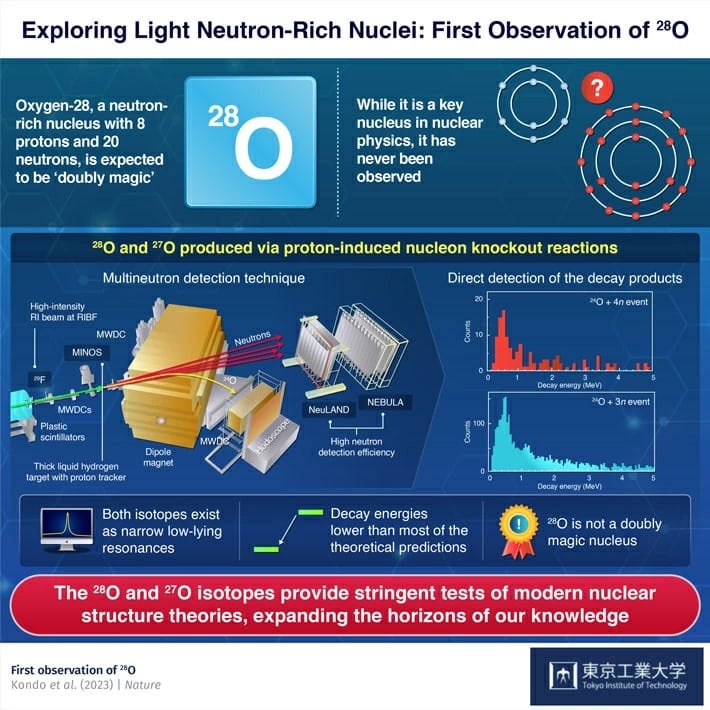Physical systems under extreme conditions can be studied to learn how they are organized and structured. Neutron-rich isotopes, exceptionally light ones with neutron-to-proton ratios markedly different from stable nuclei, offer rigorous tests of contemporary nuclear structure theories in nuclear physics. These isotopes are extremely transient resonances that decay spontaneously through neutron emission.
The first observation of two such isotopes, oxygen-28 (28O) and oxygen-27 (27O), through their decay into oxygen-24 with four and three neutrons, respectively, has been reported by an international team of researchers in a study.
In the conventional shell-model view of nuclear structure, the nucleus 28O, which has 8 protons and 20 neutrons (N), is supposed to be one of the rare “doubly magic” nuclei. However, the oxygen-28 nucleus is not “doubly magic,” as expected.
Scientists reported that the neutron-rich Oxygen isotopes oxygen-27 and oxygen-28 exist as very short-lived resonances. This is the first observation of their decay into oxygen-24 and three and four neutrons, respectively.

Scientists noted, “This study provides valuable insights into the nuclear structure.”
The RIKEN RI Beam Factory’s skills, which could generate powerful beams of unstable nuclei coupled to an active target of thick liquid hydrogen and multi-neutron detection arrays, were essential to the study’s success. Proton-induced nucleon knockout reactions from a high-energy 29F beam produced the neutron-unbound isotopes 27O and 28O. By directly observing the decay products of these isotopes, scientists could examine and learn more about them.
They discovered that 27O and 28O both exist as narrow, low-lying resonances. They compared their decay energies to the outcomes generated by complex theoretical models based on effective field theories of quantum chromodynamics. These models included a large-scale shell model computation and a newly devised statistical technique. For both isotopes, larger energy was expected by the majority of theoretical models.
Yosuke Kondo, an Assistant Professor at the Department of Physics at the Tokyo Institute of Technology, said, “Specifically, the statistical coupled-cluster calculations suggested that the energies of 27O and 28O can provide valuable constraints for the interactions considered in such ab initio approaches.”
The cross-section for the generation of 28O from the 29F beam was also examined, and scientists discovered that it was consistent with 28O not exhibiting a closed N=20 shell shape.
Dr. Kondo said, “This result suggests that the ‘island of inversion,’ whereby the energy gap between neutron orbitals weakens or vanishes, extends beyond the fluorine isotopes 28F and 29F into the oxygen isotopes.”
“The present findings enhance our understanding of nuclear structure by offering new insights, especially for extremely neutron-rich nuclei. In addition, the detailed investigation of multi-neutron correlations and the study of other exotic systems now become possible with the multi-neutron-decay spectroscopy technique utilized here.”
Journal Reference:
- Kondo, Y., Achouri, N.L., Falou, H.A. et al. First observation of 28O. Nature 620, 965–970 (2023). DOI: 10.1038/s41586-023-06352-6
Note: This article have been indexed to our site. We do not claim legitimacy, ownership or copyright of any of the content above. To see the article at original source Click Here













